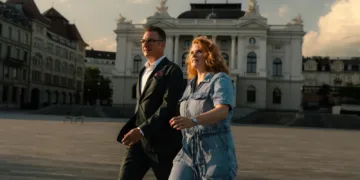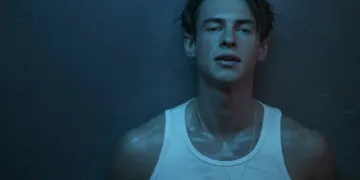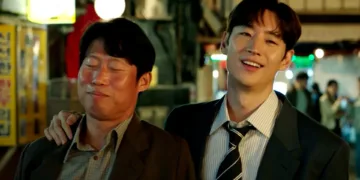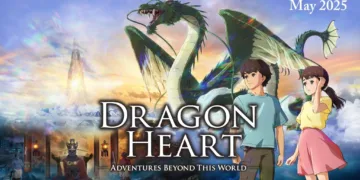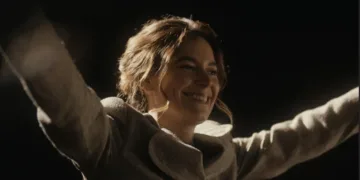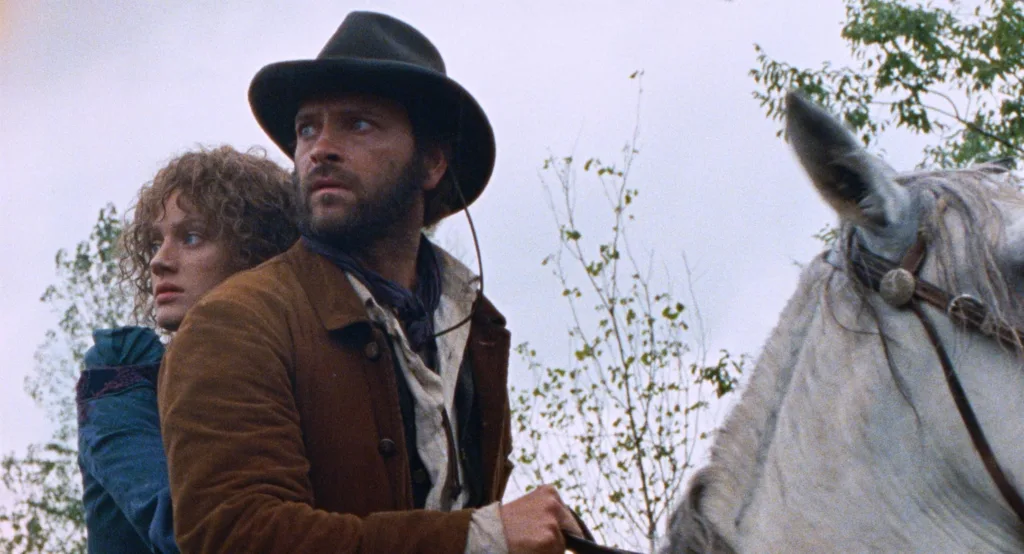The scent of sawdust and gunpowder, a phantom limb of the American frontier, drifts across the ancient stones of Italy. Here, in the twilight of the 19th century, Buffalo Bill Cody, that bewhiskered impresario of self-mythology, has imported his Wild West spectacle – a theatre of conquest played out for the amusement of a European gentry.
The performance, however, is merely a prelude, a gaudy curtain rising on a drama far less rehearsed. A wager, born of bravado and perhaps the weariness of an old world confronting a new, pits American bravura against local sinew. Santino, an Italian buttero, a man of the earth, triumphs, and in this small victory, a crack appears in the veneer of civility. A nobleman, Ercole Rupè, lies slain, and his young French widow, Rosa, her hands stained with an irrevocable act, flees into the ochre landscape.
With her rides Santino, now a cipher – murderer, kidnapper, or perhaps merely a man caught in the sudden, violent current of another’s desperate bid for freedom. And in their wake, Buffalo Bill, ever the opportunist of narrative, senses the raw material for a new legend, a fresh story to be lassoed and branded. The pursuit begins, not merely of bodies, but of a truth that will inevitably be bent to the shape of the telling.
Figures Forged in Flight and Fabrication
The flight of Rosa and Santino is less a geographical traverse than an etching of character against a stark, indifferent landscape. Rosa, portrayed by Nadia Tereszkiewicz with a simmering intensity that belies her porcelain features and flame-like curls, is the instigator, the one whose violent gesture shatters the gilded cage of her marriage. Her subsequent journey is a desperate assertion of will, an attempt to wrest authorship of her life from the hands of fate and patriarchal decree. There is a raw, almost feral quality to her resilience, a refusal to be merely a damsel or a pawn, even as the narrative strands woven by others seek to define her.
Alessandro Borghi’s Santino is a more shadowed figure, a man thrust into a legend not of his making. His initial prowess, the quiet confidence of the buttero, gives way to the bewildered heroism of the outlaw. He becomes a canvas upon which the desires and fears of a restive populace are projected, his image ballooning into that of a rebel icon. Borghi captures this transformation with a compelling physicality, his crystalline eyes reflecting both the allure of this unearned status and, perhaps, the hollowness at its core. He is the hero by accident, his identity a garment stitched by circumstance and the songs of others.
And then there is John C. Reilly’s Buffalo Bill, a magnificent edifice of American self-creation. Reilly embodies him not as a villain, but as a grand, perhaps tragic, showman, a man whose existence is inextricably bound to the stories he spins. His pursuit of the fugitives is as much about capturing a narrative as it is about capturing individuals. He is the meta-commentator, the unreliable narrator whose florid prose, meticulously transcribed by his attendant scribe, seeks to impose order and heroic gloss upon the messy, brutal realities unfolding.
His entrepreneurial spirit is a hunger for the dramatic, for the tale that will sell, revealing the commodification of experience itself. Even the grieving police chief Rupè, father to the slain Ercole, becomes a player in this grim theatre, his call for justice fueling the very myth-making machinery Bill Cody so expertly operates.
The Celluloid Skin of Truth
The visual language of Heads or Tails? is one of palpable texture, a world rendered in the rich, sometimes bruised, hues of celluloid. Shot on film, the images possess a granular depth, the Italian landscapes of Lazio and Tuscany sprawling under sunsets that bleed across the screen like fresh wounds.
There’s an almost tactile quality to the light, whether it’s the harsh glare revealing the dust and desperation, or the honeyed tones that momentarily soften the sharp edges of this fugitive existence. The initial starkness of black and white, framing the artifice of Buffalo Bill’s show within the confines of an Academy ratio, blossoms into the wider, more ambiguous canvas of color, as if reality itself has become more complex, less easily defined.
This aesthetic serves as a potent underscore to the film’s thematic preoccupations with the elusive nature of truth and the pervasive human instinct to weave narratives. Storytelling here is not merely a pastime, but a fundamental act of constructing reality, a shield against the void. Buffalo Bill’s grandiloquent voice-over, the chapter titles that punctuate the narrative like pronouncements, the folk ballads that rise from the throats of the oppressed – all are attempts to sculpt meaning from the raw, often brutal, material of events.
Yet, these stories are inherently unreliable, shaped by perspective, ambition, and the seductive allure of a good yarn. The film seems to whisper that truth is not a fixed point, but a shimmering mirage, constantly receding, constantly being rewritten by those who hold the pen, or the gun, or the gaze of the camera. Even the nascent peasant rebellion, a flicker of social unrest against the encroaching power of railway barons, becomes another thread in this tapestry of contested narratives, its heroes and villains cast by the urgent need for a story to believe in.
Where the Prairie Dissolves into Dream
While its boots are planted in the familiar soil of the Western – the lone figures against vast landscapes, the pursuit, the sudden eruption of violence – Heads or Tails? wanders far from the genre’s well-trodden paths. This is a Western refracted through a distinctly European sensibility, less concerned with manifest destiny than with the labyrinthine corridors of history and the ambiguities of the human heart. The Italian setting is not a mere backdrop but an active participant, its ancient textures and shadowed histories infusing the narrative with a sense of weary romanticism.
The film’s most arresting moments occur when it sheds its genre skin and drifts into the uncanny. A sun-dappled encounter with itinerant frog hunters, their mirrors casting unsettling reflections, feels like a passage from a half-forgotten fable, a haunting digression that speaks to the strangeness lurking beneath the surface of the everyday.
Later, the reported animation of Santino’s severed head, a grotesque interlocutor for Rosa, pushes the narrative into a space where grief, trauma, and the fantastical bleed into one another. These are not mere stylistic eccentricities, but rather incursions of the surreal that suggest a deeper, perhaps more unsettling, reality at play, a world where the boundaries between the tangible and the imagined are porous.
The tonal shifts, from the grit of the chase to the almost comedic bravado of Buffalo Bill, to these moments of stark, dreamlike beauty or horror, mirror the fractured, unpredictable nature of existence itself. Alessio Rigo de Righi and Matteo Zoppis have crafted a film that delights in its own artifice, layering stories upon stories, creating a cinematic experience that is as much a meditation on the act of seeing and telling as it is a tale of outlaws and pursuit. It is an ambitious, sometimes disquieting journey, leaving one to ponder the phantoms we chase and the stories we tell ourselves to survive the darkness.
Heads or Tails? premiered on May 22, 2025, in the Un Certain Regard section at the Cannes Film Festival.
Full Credits
Directors: Alessio Rigo de Righi, Matteo Zoppis
Writers: Alessio Rigo de Righi, Matteo Zoppis, Carlo Salsa
Producers: Tommaso Bertani, Alex C. Lo, Olivia Musini, Filippo Montalto, Stefano Centini
Cast: Nadia Tereszkiewicz, Alessandro Borghi, John C. Reilly, Peter Lanzani, Mirko Artuso, Gabriele Silli, Gianni Garko
Director of Photography (Cinematographer): Simone D’Arcangelo
Editors: Andrés Pepe Estrada, Jacopo Ramella Pajrin
Composer: Vittorio Giampietro
The Review
Heads or Tails?
Heads or Tails? is a visually sumptuous and intellectually restless film, a compelling deconstruction of Western myth and the very act of storytelling. It plunges into the murky waters where history, legend, and personal desperation collide, offering a journey that is as philosophically intriguing as it is fantastically askew. While its deliberate ambiguities and tonal shifts may not offer easy comfort, its haunting beauty and profound questions about the narratives that shape us linger with unsettling power.
PROS
- Ambitious exploration of mythmaking and truth.
- Stunning cinematography and evocative Italian landscapes.
- Strong, layered performances, particularly John C. Reilly.
- Thought-provoking engagement with existential themes.
- Unique and memorable departures into surrealism.
CONS
- Deliberately elusive narrative may frustrate some viewers.
- Tonal shifts, while thematically resonant, can be jarring.
- Pacing is contemplative and demands patience.



















